Exploring Accessibility
November 28, 2022
Some of them are stared at. Some of them are pitied. Some of them are laughed at. All of them deserve more.
For people with disabilities, accessibility is the focused effort put forth towards their necessities and the adjustments made, whether it may be facilities or products. The purpose for accessibility is to make services, activities, products and information available and meaningful to as many people as possible, no matter their differences.
In 1990, one of the ways to try to ensure more accessibility was the implementation of the Americans with Disabilities Act (ADA). The ADA was put in place to stop discrimination against disabled people. This involves transportation, communication, attainability of state and local government services, and employment. There is also the Patient Protection and Affordable Care Act (ACA) that has aspects focused on disabled people, including cost-effective health care, improved protection for disabled Americans and more health care options. Overall, our nation at large has made important strides toward making the United States more accessible for people with disabilities.
In this package, Eastside explores how Cherry Hill schools and the Cherry Hill community are striving to increase accessibility, looking at the advances and barriers that have defined its evolution.
Looking at accessibility within Cherry Hill schools: Physical Accessibility
At Cherry Hill High School East, multiple aspects of the school’s infrastructure are designed to be inclusive for students with physical disabilities. For example, there is an elevator to assist with going to different floors, ramps at major entrances for students to come in and lever door handles on some doors for easier use. In the classroom, teachers wear amplifiers on their lanyards to assist students who are hard of hearing and with students with central auditory processing disorder, and the custodial team provides extra cleaning in rooms where students may have significant allergies, among other measures.
While there has been progress in making East an accessible learning environment for all students, there are more strides that still need to be made to aid students with physical disabilities. For instance, every time a student has to use an elevator, they have to wait for an adult with a key to take them up and down — an inefficient mode of transportation in the limited time between classes. Additionally, the student entrance, which most students use when entering East in the morning, does not have a ramp, making it inaccessible for students with wheelchairs and other students with physical disabilities. Furthermore, many door handles have not yet been replaced with lever handles, making them difficult for handicapped students and staff to operate. This problem has long gone unaddressed, since East only adds lever handles to doors that already require replacement for an- other reason (for example, if one is broken), since the American Disabilities Act (ADA) requires that any changes made to a school facility must be ADA compliant.
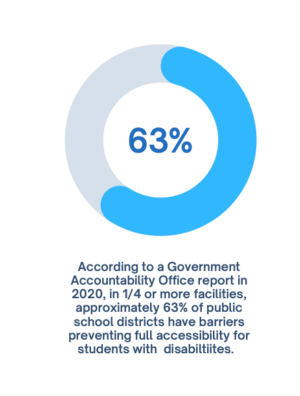
Regarding these issues, East Principal Dr. Dennis Perry said that the recently passed bond referendum would make the entire building ADA compliant. The bond has an extensive agenda for making areas at East more accessible: the student entrance, bleachers in the DiBart Gym, new classroom doors with accessible handles, the turf field system and new construction will all be made to be accessible as according to the ADA.
Moreover, within the community there are many organizations trying to provide accessible activities for people with physical disabilities. Popular programs and places within the community include Miracle League and Jake’s Place.
“[The] notion of equity… doesn’t mean anyone… is slighted in any way. It just simply means that everyone is getting what they need,” said Perry. “There is a famous cartoon for equity… It’s three kids trying to look over the fence to watch a game and the kids are at different heights so one is on a taller box so that they could all see the same thing. It’s the same idea.”
It’s time everyone can finally see.
Looking at accessibility within Cherry Hill schools: Learning Accessibility
“Special education [is] like putting a square peg in a small round hole,” said Cherry Hill Special Education PTA (CHSEPTA) President Jennifer Naddeo. In other words, there is simply no “one
size fits all” approach when it comes to students’ learning. With students of all different interests and abilities in our classrooms, it is not practical to assume that they will all thrive under the same
teaching and evaluation methods.
Currently, Cherry Hill offers Individualized Education Program (IEP) and 504 plans for students with learning disabilities.
Perry explained that for students who have a 504 plan, accommodations for learning needs can include extra time on tests, reduced homework loads, notes from teachers and more. 504 plans also extend to physical accommodations, such as elevator access or audio systems to aid students who are hard of hearing.
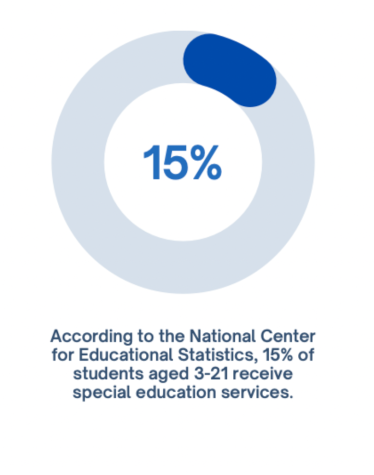
At East, each grade level has a committee, headed by the grade level’s assistant principal, whose purpose is to review and evaluate requests for 504 plans for students in that grade. To apply for a 504 plan, a student must first submit evidence of a medical diagnosis and demonstrate a need for accommodations. From there, the student’s parents, guidance counselor, grade level assistant principal and teachers meet to design the ideal accommodations plan for the student.
Compared to a 504 plan, an Individualized Education Program (IEP) provides more extensive accommodations by creating a unique, modified learning plan for each student.
Different levels of IEP plans can include having a special education teacher make modifications to students’ learning, having an inclusion teacher in the classroom and using a different educational program as a whole. For students who are looking to get an IEP, they first go through an evaluation meeting that can be based on if a teacher or parent sees that they are struggling in different areas. The evaluation can be based on many different topics including speech, occupational therapy and functional behavior, and is used to see what is being affected and how to help. After the evaluation meeting, an eligibility meeting occurs, following strict guidelines of testing, to see if a student is eligible for special education services. Once the family receives the results, a team of people including a case manager, general education teacher, special education teacher, family and more people depending on the circumstances (including the student “whenever appropriate” according to the Individuals with Disabilities in Education Act), reads the evaluation and decides whether the IEP should be granted. The team will meet yearly to reevaluate the accommodations offered to the student if an IEP is granted.
The CHSEPTA’s mission statement is “to offer support, education, socialization and advocacy for children with special learning needs, their families and educators.” CHSEPTA helps students and families by providing information about services and programs throughout our district.
Naddeo still shows that change needs to be made to make Cherry Hill an accessible place for all students.
“I get calls [from families] where everything worked out fine, and they love their program, they love their teacher, they think that their students are doing fantastic in Cherry Hill School District… And then, we get the phone calls where it’s almost like communication is shut down and it doesn’t feel like their student has been welcomed or accepted and they’re not able to get what they need.”
Naddeo is advocating for changes to be implemented into the education system, one of which is providing more in-class resources, especially for Advanced Placement (AP) and honors-level classes as well as required classes such as Financial Literacy.
With an in-class resource program, a class is led by two teachers — one subject teacher and one special education teacher (the in-class resource teacher). The in-class resource teacher provides specialized instruction for students with learning disabilities. In this way, students can take highly rigorous classes while also making sure their educational needs will be met. In-class resources are especially needed in honors and AP level classes, said Naddeo, because of the emphasis placed on taking high level courses in today’s college admissions.
Currently, it is unlawful to deny a student with a disability admission to an accelerated class or program solely because of that student’s need for special education or related aids and services, or because that student has an IEP or 504 plan. While our school district does allow students with disabilities access to advanced classes, it doesn’t provide the necessary support for students due to a lack of in-class resources.
There still remains a stigma associated with learning accommodations and the misconception that students with such plans are given an “unfair advantage.” “
I wear glasses as an accommodation for my eyesight, and if I don’t wear my glasses, it makes it challenging for me to read things [or] to see things and it might take longer to focus and I might not understand something as well… For students that may not have any kind of reading challenges, dyslexia,
things like that, you may not understand the needs [of] someone who does,” said Perry.
Regarding the accommodations that could be executed, there are many ways schools can make facilities more accessible for people with disabilities. For example, schools could implement a system for recording the lessons for those who may need extra time to grasp the information provided. Lastly, teachers should also keep in mind the distractions that may impact some disabled students’ ability to learn. This includes students walking around in the hallways and having other students in too-close settings such as when using tables that are not large enough.
Learning, equity, and acceptance: accessibility can affect all three drastically, impacting the environment that a student relates to their education.
“When our children go into a school, what I hope is that they’re accepted by their classmates, because that makes a big difference in someone’s learning,” said Naddeo.
Miracle League: Allowing all children to score a home run
Miracle League is an organization that provides children with disabilities a chance to play baseball. This organization began in 1998 when Eddie Bagwell, Rockdale Youth Baseball Association’s coach, invited a child in a wheelchair to play baseball on his team. Since then, many children with disabilities have begun playing baseball as part of over 300 Miracle League Organizations in the U.S.
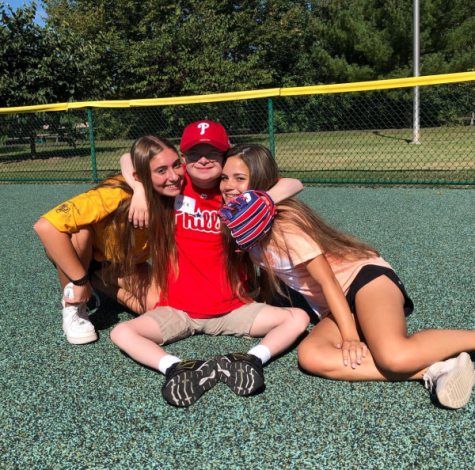
In the leagues, all of the players get to bat once each inning, every athlete can score a run before the inning is over, volunteers can be ‘buddies’ to the athletes and help them throughout the games, and each team/player is seen as a winner in every game.
Cherry Hill High School East participates in this mission through its Miracle League club. Students are encouraged to work as volunteers at the games.
“It’s our job to get students…to sign up to go and be like buddies…so our students play baseball with…the children who show up to play,” said Mrs. Radbill, the Miracle League club advisor.
The Miracle League club attends the Camden County Miracle League games at Jake’s Place playground. Jakes Place playground has boundless fields that help people using wheelchairs move without restrictions. The Miracle League club attends games every Saturday in the fall during September and October, then in the spring during April and May.
Miracle League spreads joy across the country by providing children with disabilities opportunities to do activities they might not get to do on their own.
“It’s just really heartwarming when a kid…gets a hit and the whole place is cheering for him or her,” said Mrs. Radbill.

If you would like to register to become a ‘buddy’ for the Camden County Miracle League, follow the club’s Instagram page (@chemiracleleague) and click the link in their bio to register. Also, if you want to learn more about the nonprofit organization, visit miracleleague.com for more details.
Voorhees Pediatric Facility: Providing a home for medically fragile children
East student volunteer Elizabeth Le (‘23) and a VPF resident smile for a picture.
Since first opening its doors in 1982, the Voorhees Pediatric Facility (VPF) has served as a special care nursing facility to provide holistic care for medically fragile children, from newborn to age 21. The facility’s residents typically have complex medical conditions and thus need access to constant specialized care. The facility is a full-time home for these children, allowing them to learn and thrive in an environment designed to meet their needs.
Currently, VPF provides care to 110 residential patients — children who all live at the facility full time. An additional 24 kids bus in each day for the facility’s Medical Day Care, where they can go through the school day while also receiving their needed medical attention and care.
Each day, just like any other child, VPF’s patients get ready for and attend school at the facility’s in-house Bancroft School, a local school program focused on special education. In between their therapy sessions, the children learn, play, and just do ordinary kid things.

“[Sometimes I’ll] just be working during the day and hear music blasting, and I’ll go outside and there’s a DJ and all the kids are out there with a dance party out of nowhere, unplanned,” said Voorhees Pediatric Facility administrator Pizzichillo. From weekly outings to the movies, to the mall, or even just to get a haircut, the facility does their best to get the patients out in the community and allow them to make the same fun memories as other children.
In addition to nurses and therapists, the VPF team also includes over a hundred volunteers, many of whom are high school students.
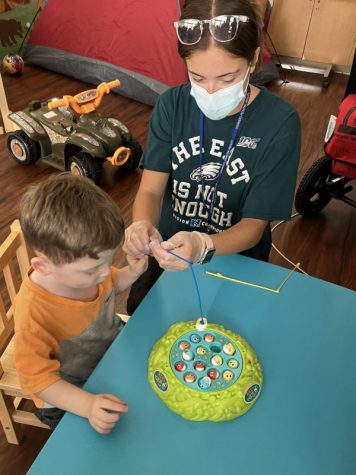
“It’s rewarding knowing that people may not get to visit [the kids] very often [and] you’re keeping them company [and] having fun with them,” said East student Lizzie Le (‘23) has been volunteering at VPF since 2020. Volunteers like Le help out by keeping the kids engaged and active: for example, they sing and dance together and play games, from “Candyland” to “Sorry!” to “Connect 4”.
Even with facilities like VPF, however, medical accessibility remains challenging for many children. When compared to that of adults, the availability of local medical treatments is lacking: sometimes there may only be one option for one of VPF’s patients to receive their needed treatment, says Pizzichillo, and it is hours away in North Jersey.
Nevertheless, although there are still roadblocks to be overcome, the Voorhees Pediatric Facility is helping children with medical conditions live life to the fullest — one therapy session, one impromptu dance party, one smile at a time.
Conclusions
Cherry Hill has made significant strides in making the community an accessible place for all. Through special programs, parks, educational resources and more, many people who need accommodations find a welcoming and accessible environment in Cherry Hill. Yet, there are still strides that need to be made and changes that need to be sought.
Without spreading awareness, it is difficult to understand the necessity of implementing accessibility in the world around us. It is our job as citizens to promote change for everyone to be able to do daily tasks without obstacles such as a lack of accessibility. From this, it is significant that we become educated in order to fully grasp the dire need of accessibility in society today. We can make strides so that everyone is educated and they all do understand how accessibility does not lead to unfairness, but rather leads to a more equitable world.
Change can start at the administrative level, or it can even start with you. Because when the citizens that construct the environment of a community come together to make a place more welcoming, that can be a stepping stone toward a society, and then a world, that is fully accessible.



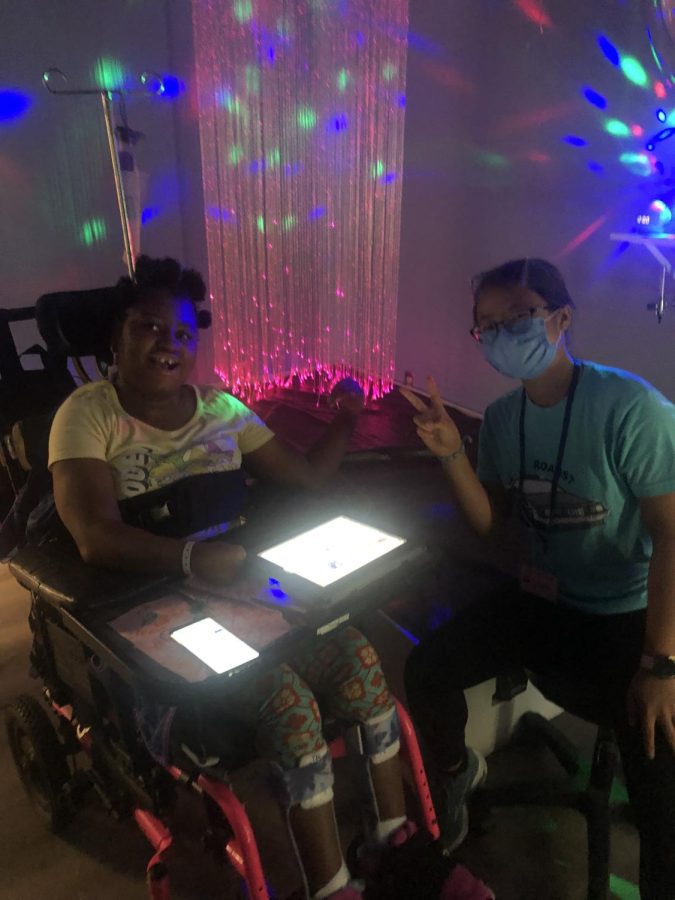
Mindy • Nov 28, 2022 at 5:40 pm
Thank you so much for writing this